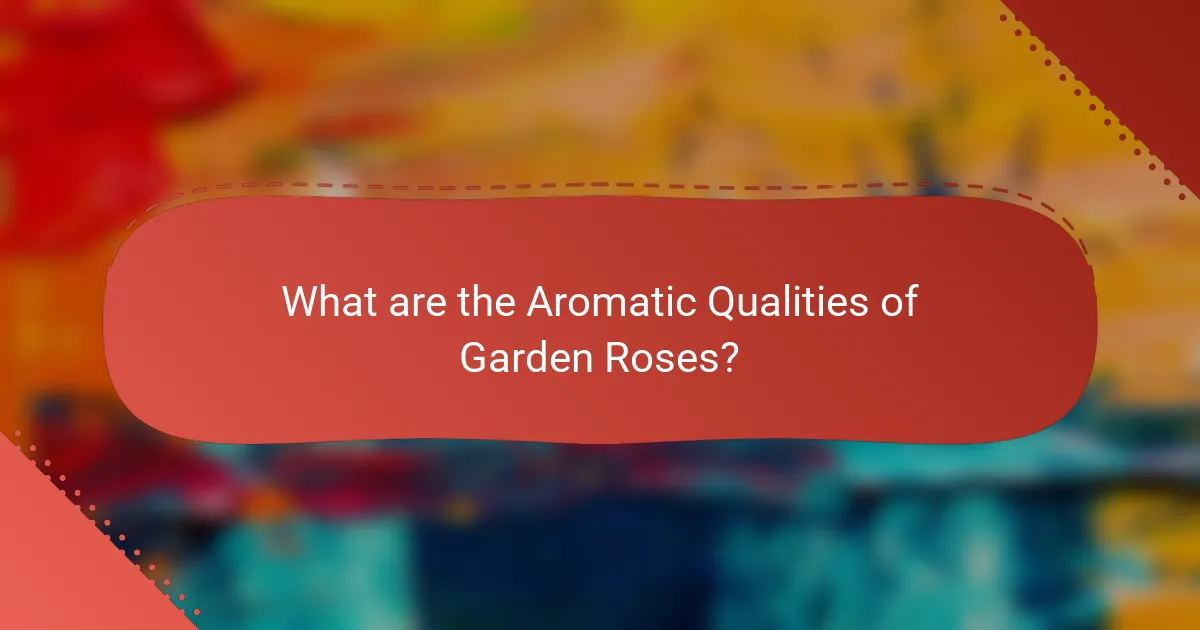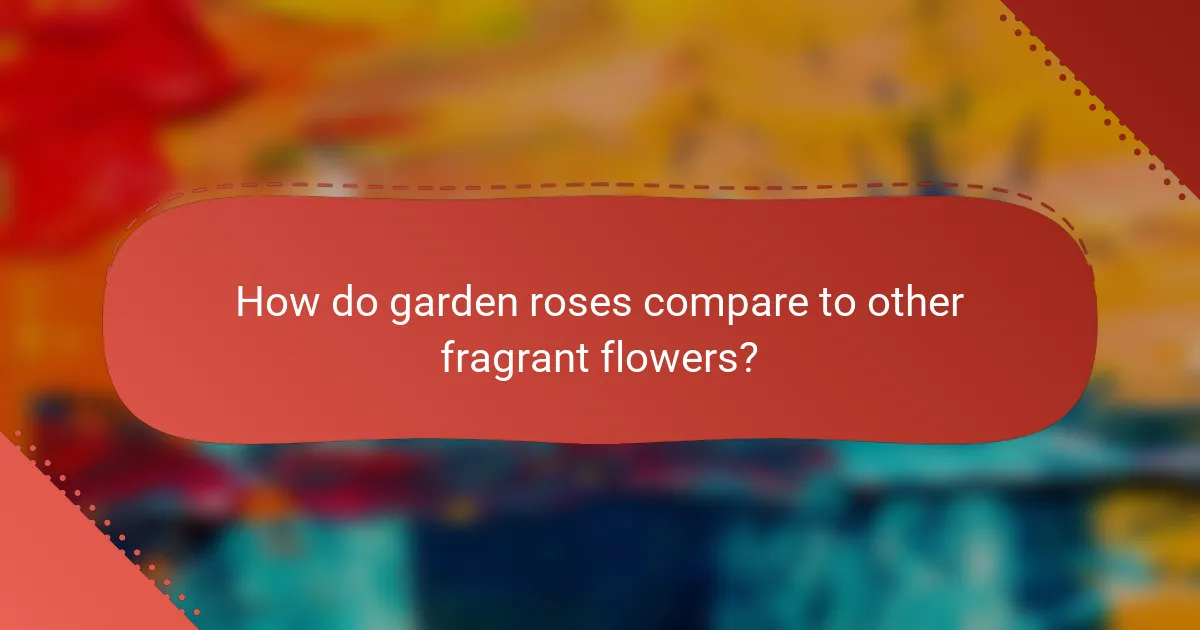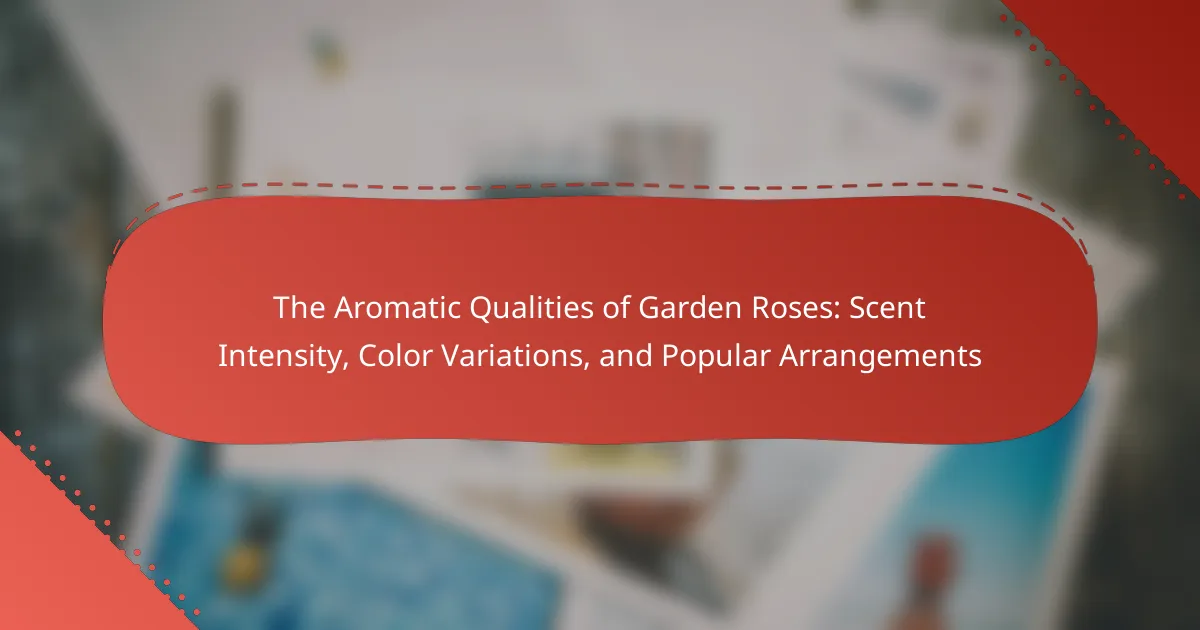
What are the Aromatic Qualities of Garden Roses?
Garden roses possess a diverse range of aromatic qualities. Their scents can vary significantly based on the variety. Common aromatic profiles include fruity, floral, spicy, and musky notes. The intensity of these scents can range from subtle to strong. For example, hybrid tea roses are known for their strong, classic rose fragrance. In contrast, some shrub roses may have a lighter scent. Additionally, the color of the rose can influence its aroma; darker varieties often have more intense fragrances. The aromatic qualities of garden roses contribute to their popularity in gardens and floral arrangements.
How does scent intensity vary among different garden rose varieties?
Scent intensity varies significantly among different garden rose varieties. Some varieties, like ‘Double Delight’, are known for their strong fragrance. Others, such as ‘Peace’, have a moderate scent. Additionally, some roses, like ‘Knock Out’, are bred for low fragrance. The variation in scent can be attributed to genetic factors and the concentration of aromatic compounds. For instance, roses with higher levels of geraniol tend to have a more intense scent. Research has shown that scent intensity can also be influenced by environmental conditions, such as soil type and climate.
What factors influence the scent intensity of garden roses?
The scent intensity of garden roses is influenced by several factors. Genetic makeup plays a crucial role in determining scent strength. Different rose varieties possess unique scent profiles due to their specific genetic traits. Environmental conditions also significantly impact scent intensity. Factors such as temperature, humidity, and sunlight exposure can enhance or diminish fragrance. Additionally, the age of the flower affects its scent. Younger blooms typically emit stronger fragrances than older ones. Lastly, soil quality and nutrition can influence the aromatic compounds produced by the plant. Healthy soil promotes robust growth and, subsequently, more intense scents.
How can scent intensity be measured in garden roses?
Scent intensity in garden roses can be measured using gas chromatography. This method analyzes the volatile compounds released by the flowers. A sample of the rose’s scent is collected and introduced into a gas chromatograph. The machine separates the components of the scent based on their chemical properties. Each compound’s concentration is quantified, providing a measure of scent intensity. Studies have shown that specific compounds correlate with perceived fragrance strength. For example, higher levels of certain terpenes indicate stronger scents. This scientific approach allows for accurate and reproducible measurements of rose scent intensity.
What color variations are found in garden roses?
Garden roses exhibit a wide range of color variations. Common colors include red, pink, white, yellow, and orange. Some roses may also present shades like lavender, peach, and cream. Additionally, certain varieties display bi-color or multi-color patterns. The diversity in colors is due to hybridization and selective breeding. This results in unique hues and combinations that enhance their visual appeal.
What are the most common color variations of garden roses?
The most common color variations of garden roses include red, pink, white, yellow, and orange. Red roses symbolize love and passion. Pink roses convey admiration and gratitude. White roses represent purity and innocence. Yellow roses signify friendship and joy. Orange roses express enthusiasm and desire. These colors are widely cultivated and appreciated in gardens worldwide. Their popularity is due to their aesthetic appeal and symbolic meanings.
How do color variations affect the perception of scent in garden roses?
Color variations in garden roses significantly influence the perception of their scent. Different colors can evoke distinct emotional responses, which may alter how individuals perceive fragrance intensity. For instance, studies show that red roses are often associated with stronger, more intense scents compared to lighter colors like pink or white. This perception can be linked to cultural associations and psychological factors tied to color. Additionally, research indicates that the chemical composition of rose oils varies with color, impacting scent profiles. For example, yellow roses may contain different volatile compounds than red roses, leading to unique aromatic experiences. Thus, color not only enhances visual appeal but also plays a crucial role in scent perception.
Why are popular arrangements of garden roses significant?
Popular arrangements of garden roses are significant because they enhance aesthetic appeal and convey emotions. These arrangements showcase the diverse colors and scents of garden roses. The visual impact of well-arranged roses can elevate the ambiance of any space. Additionally, specific arrangements are often associated with particular meanings or sentiments. For instance, red roses symbolize love, while yellow roses represent friendship. Their popularity in events like weddings and celebrations underscores their cultural relevance. Studies indicate that floral arrangements can positively influence mood and well-being. Thus, the significance of popular arrangements lies in their beauty, emotional expression, and psychological benefits.
What are the most popular arrangements featuring garden roses?
The most popular arrangements featuring garden roses include bouquets, centerpieces, and wreaths. Bouquets often combine garden roses with greenery and complementary flowers. Centerpieces typically showcase garden roses in various heights and styles, enhancing table aesthetics. Wreaths use garden roses for seasonal decorations, adding a touch of elegance. These arrangements leverage the unique colors and scents of garden roses. Garden roses are favored for their lush blooms and fragrance. Their versatility allows for creative combinations in floral design.
How do different arrangements enhance the aromatic qualities of garden roses?
Different arrangements enhance the aromatic qualities of garden roses by optimizing scent distribution. When roses are grouped closely, their fragrance intensifies due to the concentration of volatile compounds. This arrangement allows for a more potent olfactory experience. Additionally, varying heights and placements can create airflow patterns that disperse scents more effectively. For example, taller roses can release fragrance higher into the air, while lower arrangements can trap and amplify scents closer to the observer. Research indicates that the interplay of colors and shapes in arrangements can also influence perceived scent strength. This means that not only does the physical arrangement matter, but also the visual appeal can enhance the overall aromatic experience.

How do garden roses compare to other fragrant flowers?
Garden roses are known for their strong and sweet fragrance, often considered more intense than many other fragrant flowers. Their scent profile varies significantly, with some varieties emitting a classic rose scent, while others may have fruity or spicy notes. In comparison, flowers like lilies or jasmine also have notable fragrances, but their scent intensity can differ. For instance, jasmine is often described as intoxicating but may not be as universally appealing as the scent of garden roses. Additionally, garden roses are cultivated for their aroma in various arrangements, enhancing their appeal in floral design. Studies indicate that the olfactory perception of roses is generally favored in consumer preferences, making them a popular choice for gardens and bouquets.
What unique attributes set garden roses apart from other flowers?
Garden roses are distinct from other flowers due to their rich fragrance, diverse color palette, and unique petal structure. Their scent intensity often surpasses that of hybrid or wild roses. Garden roses exhibit a wide range of colors, including pastel shades and vibrant hues, which are less common in other flower types. The petal structure of garden roses is typically fuller and more layered, contributing to their aesthetic appeal. Additionally, garden roses often have a longer blooming period compared to many other flowers. These attributes make garden roses particularly sought after for floral arrangements and gardens.
What are the rare scent profiles found in specific garden rose varieties?
Rare scent profiles in specific garden rose varieties include unique aromas such as myrrh, clove, and anise. For example, the ‘Heritage’ rose is known for its strong myrrh scent. The ‘Climbing Iceberg’ rose exhibits a rare clove fragrance. Additionally, the ‘Madame Isaac Pereire’ rose features a distinctive anise scent. These scent profiles are less common compared to typical rose fragrances. The diversity in scent arises from the genetic makeup of each variety. Specific breeding practices can enhance these rare aromas. Such unique scents contribute to the overall appeal of these roses in gardens.
How can the aromatic qualities of garden roses be utilized in different settings?
The aromatic qualities of garden roses can be utilized in various settings for enhancing ambiance and sensory experiences. In home decor, garden roses can be arranged in vases to provide a pleasant fragrance that uplifts indoor spaces. In aromatherapy, essential oils extracted from garden roses can promote relaxation and emotional well-being. For events like weddings, the scent of garden roses can create a romantic atmosphere, making them popular in floral arrangements. In culinary applications, rose petals can be used as flavoring agents in dishes and beverages. Furthermore, garden roses are often employed in spa settings for their soothing aroma, contributing to a calming environment. Their versatility in scent makes garden roses suitable for both personal and commercial use.
What are the best practices for using garden roses in floral arrangements?
The best practices for using garden roses in floral arrangements include selecting fresh blooms, trimming stems at an angle, and removing excess foliage. Fresh blooms ensure longevity and optimal appearance in arrangements. Trimming stems at an angle increases water absorption, helping the roses stay hydrated. Removing excess foliage prevents bacterial growth in the water, maintaining freshness. Additionally, grouping roses by color creates a visually appealing arrangement. Using a variety of sizes adds depth and interest. Finally, changing the water regularly extends the life of the arrangement. These practices enhance the overall quality and aesthetic of floral displays.

What practical tips can enhance the enjoyment of garden roses?
To enhance the enjoyment of garden roses, regular deadheading is essential. This practice encourages new blooms and maintains the plant’s appearance. Additionally, providing adequate water is crucial. Roses require about an inch of water weekly, especially during dry spells.
Applying mulch helps retain soil moisture and suppress weeds. Fertilizing roses with a balanced fertilizer supports healthy growth and vibrant blooms. Pruning in early spring shapes the plant and removes any dead or diseased wood.
Choosing disease-resistant varieties can reduce maintenance and increase enjoyment. Lastly, placing roses in a sunny location ensures they receive at least six hours of sunlight daily, promoting optimal health and fragrance.
How can one select the best garden roses for fragrance?
To select the best garden roses for fragrance, focus on specific varieties known for their scent. Hybrid tea roses, for example, are often celebrated for their strong aroma. Look for roses with names that include “fragrance” or “scent” in their descriptions. Additionally, older varieties, such as David Austin roses, are typically bred for their fragrance. Evaluating the intensity of the scent can be done by smelling the blooms at different times of day. Roses that release their fragrance in the morning tend to have a more pronounced scent. Research indicates that certain colors, like deep reds and pinks, are often associated with stronger aromas. Selecting roses with multiple petals can also enhance fragrance, as they tend to hold more essential oils. Finally, consult local gardening experts or resources to identify the best fragrant varieties for your specific climate.
What care tips help maintain the aromatic qualities of garden roses?
To maintain the aromatic qualities of garden roses, proper care is essential. Regular watering ensures the plants remain hydrated, which enhances their fragrance. Fertilizing with a balanced rose fertilizer promotes healthy growth and scent production. Pruning dead or diseased stems encourages air circulation, reducing fungal issues that can affect aroma. Additionally, planting roses in well-drained soil supports root health, contributing to overall scent intensity. Lastly, protecting roses from extreme temperatures helps preserve their fragrant oils. These practices collectively enhance the aromatic experience of garden roses.
What common mistakes should be avoided when arranging garden roses?
Common mistakes to avoid when arranging garden roses include overcrowding the arrangement. Overcrowding can lead to poor air circulation and hinder growth. Additionally, neglecting to vary the heights of the roses can create a flat appearance. Using roses that are not compatible in terms of scent or color can also detract from the overall aesthetic. Failing to consider the foliage can result in a lack of texture and depth. Lastly, not taking into account the vase size can lead to instability and tipping. Each of these mistakes can diminish the beauty and longevity of the arrangement.
The main entity of the article is garden roses, which are characterized by their aromatic qualities, including varying scent intensities and a wide range of color variations. The article explores how different garden rose varieties exhibit distinct aromatic profiles influenced by genetic factors and environmental conditions. It also discusses the significance of popular arrangements, how color affects scent perception, and practical tips for selecting and caring for fragrant roses. Additionally, the article highlights unique scent profiles and best practices for enhancing the enjoyment and longevity of garden roses in various settings.
